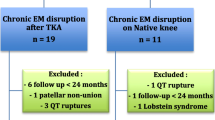Abstract
Background
Extensor mechanism allograft provides an effective remedy for severe quadriceps deficiency caused by loss of the patella, patellar tendon, and quadriceps tendon in TKA. Late failure is common, however, and major quadriceps deficiency occurs after removal of the allograft material.
Description of Technique
Six human cadaver specimens were dissected to evaluate the feasibility of transferring the vastus medialis, vastus lateralis, and medial head of the gastrocnemius muscle to fill the defect caused by loss of the patella and extensor tendon mechanism after failure and removal of allograft material. Transfer of the medial and lateral vastus muscles with their distal attachments into the tibia achieved closure of the defect but did not provide robust tendon material to fill the defect in the anterior knee. The medial gastrocnemius muscle reached easily to the muscular portion of the vastus medialis and lateralis flaps and provided secure closure of the anterior knee and strong attachment of viable muscle and tendon.
Methods
Five knees (five patients) with failed patella-patellar tendon allograft between August 2008 and April 2010 were repaired using this technique.
Results
Mean extensor lag was 47° (range, 35°–62°) before surgery and improved to 12° (range, 5°–15°) 1 year after surgery.
Conclusions
These preliminary results suggest that the described muscle transfer technique may provide an approach to salvage the failed extensor mechanism allograft after TKA.
Level of Evidence
Level IV, therapeutic study. See Guidelines for Authors for a complete description of levels of evidence.










Similar content being viewed by others
References
Barrack RL, Lyons T. Proximal tibia-extensor mechanism composite allograft for revision TKA with chronic patellar tendon rupture. Acta Orthop Scand. 2000;71:419–421.
Barrack RL, Stanley T, Allen Butler R. Treating extensor mechanism disruption after total knee arthroplasty. Clin Orthop Relat Res. 2003;416:98–104.
Browne JA, Hanssen AD. Reconstruction of patellar tendon disruption after total knee arthroplasty: results of a new technique utilizing synthetic mesh. J Bone Joint Surg Am. 2011;93:1137–1143.
Burnett RS, Berger RA, Paprosky WG, Della Valle CJ, Jacobs JJ, Rosenberg AG. Extensor mechanism allograft reconstruction after total knee arthroplasty: a comparison of two techniques. J Bone Joint Surg Am. 2004;86:2694–2699.
Burnett RS, Butler RA, Barrack RL. Extensor mechanism allograft reconstruction in TKA at a mean of 56 months. Clin Orthop Relat Res. 2006;452:159–165.
Busfield BT, Ries MD. Whole patellar allograft for total knee arthroplasty after previous patellectomy. Clin Orthop Relat Res. 2006;450:145–149.
Crossett LS, Sinha RK, Sechriest VF, Rubash HE. Reconstruction of a ruptured patellar tendon with Achilles tendon allograft following total knee arthroplasty. J Bone Joint Surg Am. 2002;1354–1361.
Emerson RH Jr, Head WC, Malinin TI. Reconstruction of patellar tendon rupture after total knee arthroplasty with an extensor mechanism allograft. Clin Orthop Relat Res. 1990;260:154–161.
Emerson RH Jr, Head WC, Malinin TI. Extensor mechanism reconstruction with an allograft after total knee arthroplasty. Clin Orthop Relat Res. 1994;303:79–85.
Gray H. Gray’s Anatomy. 1901 ed. Philadelphia, PA, USA: Running Press; 1974.
Jaureguito JW, Dubois CM, Smith SR, Gottlieb LJ, Finn HA. Medial gastrocnemius transposition flap for the treatment of disruption of the extensor mechanism after total knee arthroplasty. J Bone Joint Surg Am. 1997;79:866–873.
Lahav A, Burks RT, Scholl MD. Allograft reconstruction of the patellar tendon: 12-year follow-up. Am J Orthop (Belle Mead NJ). 2004;12:623–624.
Krackow KA. The Technique of Total Knee Arthroplasty. St Louis, MO, USA: CV Mosby; 1990.
Leopold SS, Greidanus N, Paprosky WG, Berger RA, Rosenberg AG. High rate of failure of allograft reconstruction of the extensor mechanism after total knee arthroplasty. J Bone Joint Surg Am. 1999;81:1574–1579.
Nazarian DG, Booth RE Jr. Extensor mechanism allografts in total knee arthroplasty. Clin Orthop Relat Res. 1999;367:123–129.
Prada SA, Griffin FM, Nelson CL, Garvin KL. Allograft reconstruction for extensor mechanism rupture after total knee arthroplasty: 4.8-year follow-up. Orthopedics. 2003;26:1205–1208.
Ries MD. Skin necrosis after total knee arthroplasty. J Arthroplasty. 2002;17(Suppl 1):74–77.
Springer BD, Della Valle CJ. Extensor mechanism allograft reconstruction after total knee arthroplasty. J Arthroplasty. 2008;23(Suppl):35–38.
Whiteside LA. Surgical technique: transfer of the anterior portion of the gluteus maximus muscle for abductor deficiency of the hip. Clin Orthop Relat Res. 2012;470:503–510.
Whiteside LA. Surgical technique. Vastus medialis and vastus lateralis as flap transfer for knee extensor mechanism deficiency. Clin Orthop Relat Res. 2013;471:221–230.
Whiteside LA, Nayfeh TA, Katerberg BJ. Gluteus maximus flap transfer in total hip arthroplasty. Clin Orthop Relat Res. 2006;453:203–210.
Acknowledgments
I thank William C. Andrea MS, CMI, for preparation of the illustrations and Diane J. Morton MS, for assistance with the manuscript.
Author information
Authors and Affiliations
Corresponding author
Additional information
Each author certifies that he, or a member of his immediate family, has no funding or commercial associations (eg, consultancies, stock ownership, equity interest, patent/licensing arrangements, etc) that might pose a conflict of interest in connection with the submitted article.
All ICMJE Conflict of Interest Forms for authors and Clinical Orthopaedics and Related Research editors and board members are on file with the publication and can be viewed on request.
Clinical Orthopaedics and Related Research neither advocates nor endorses the use of any treatment, drug, or device. Readers are encouraged to always seek additional information, including FDA-approval status, of any drug or device prior to clinical use.
The author certifies that his institution approved the human protocol for this investigation, that all investigations were conducted in conformity with ethical principles of research, and that informed consent for participation in the study was obtained.
About this article
Cite this article
Whiteside, L.A. Surgical Technique: Muscle Transfer Restores Extensor Function After Failed Patella-Patellar Tendon Allograft. Clin Orthop Relat Res 472, 218–226 (2014). https://doi.org/10.1007/s11999-013-3101-9
Published:
Issue Date:
DOI: https://doi.org/10.1007/s11999-013-3101-9




